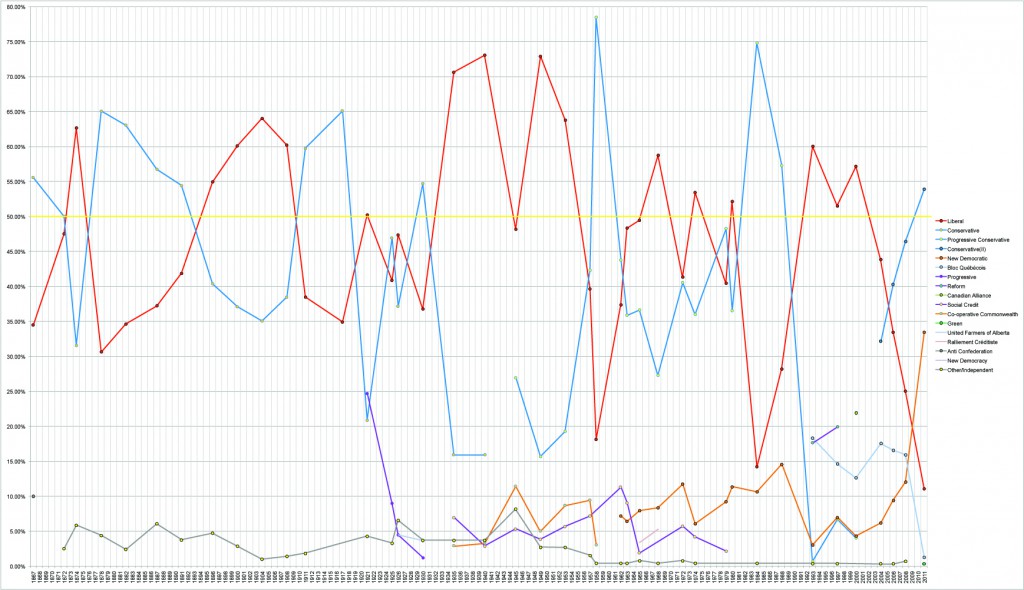I’m sorry, but I don’t have much sympathy for Americans (or anyone) complaining that, for the US presidential election of 2016, there are only two bad choices to choose from; those that wish there were other choices; those that wish the parties had nominated different candidates. To me, these people are like children who, when presented with the option of having a cupcake or a cookie, cry and say they want a Popsicle. Well, there are no popsicles; you only have two choices, and you have to pick one, or one will be picked for you and you may not like the result.
The US Presidential Election system has, essentially, devolved into a “two party” system, but it has pretty much always been a two-party system, particularly after the formation of the Republican Party after the election of 1852, with only a few exceptions. In the last 100 years, there have only been six elections where a third party candidate managed to get even a small portion of the popular vote, and even then, the impact on the election results were negligible.
I would agree that there are many aspects of the overall system that need to be reviewed and possibly changed and hopefully improved. The perceived problems of the system are likely the cause of apparent voter apathy; voter turnout over the past 50 years has averaged barely over 50%. The process by which the parties select their candidates is unbelievably complicated. I totally do not understand the reasoning behind the Electoral College concept. It takes a system by which individuals vote directly for their preferred presidential candidate and turns it into a “first past the post” system, because the individual votes don’t chose the president, the Electoral College votes (cast by the States themselves) do…
But it’s a bit late to be complaining about these facts now. You vote in the system you have, not in the system you wish for, because “… if wishes were horses, we’d all be eating steak.”
In this election, there has been a fair amount of support for the third, independent candidate. Historically, the only time a third party candidate had any significant effect on the election, by getting more of the popular vote and more electoral college votes than one of the two main parties, was in 1912, when Teddy Roosevelt, a former (and popular) President was running under the “Progressive Party” banner. And even then, he only finished a distant second place behind the Democratic candidate (Woodrow Wilson) in the Electoral College, even though Wilson had less than 42% of the popular vote.
Voting in US Presidential elections has always a very close call sort of thing; in the last ten elections or so the popular vote ended up, at most, as a 60/40 split, and usually closer to 50/50. A significant percentage of the voting population tend to vote for one of the two main parties no matter what the issues are, no matter who the candidates are. “I always vote {democrat/republican} because my daddy and my daddy’s daddy always voted {democrat/republican} and that’s just the way it is.” Elections are usually decided in a fight for the small percentage of undecided and independent registered voters.
Voting for an independent candidate is very much like not voting at all, since they are highly unlikely to ever get enough votes to win. Even worse, votes that go to a third party candidate can split the vote, and cause candidates with lower popular vote results to get more electoral college votes than they really deserve, due to the “first past the post” aspect of the system. This is likely what happened in 1912.
Sure, in this election both main candidates have issues. But the media has been consistently trying to portray it as a “close race,” emphasising some of the so-called scandals to try to create a false sense of both candidates being equally bad, because a close race is a news story that generates viewers and makes money. But the reality is, it’s not close. Not at all. One of the candidates is orders of magnitude worse than the other, by any measure anyone would care to use. One candidate is competent, balanced, experienced and qualified for the job, despite any minor transgressions that have been blown out of all proportion by the media, and have been investigated thoroughly with no charges filed. The other candidate is flagrantly unqualified, dangerously unstable, intolerably ignorant, misogynistic, hate-filled, deceptive, mendacious, small minded, elitist, pompous, hypocritical, plutocratic, racist and far less successful, business-wise, than many people assume… and should by no means ever be given any job that involves authority or responsibility over anyone, much less the leadership of one of the most powerful nations on Earth. Simply put; the absolutely worst candidate for the office of President in the history of the United States. Sure, nobody likes being in the situation of having to pick the “least worst” option, but in this election, doing that should be a total no-brainer for anyone.
All this combines to make this one of the most important presidential elections in history, even if it is the sort of thing the founding fathers would probably have had nightmares about. You can’t change the system now; it’s too late for that. This is the system you have, and these are the candidates you have, America. Once this election is done, you can (should!) work to make changes to keep it from happening again. In the past, many voters didn’t care who became president because there was little to distinguish one candidate from the other. But this year it’s different. The differences between the candidates are massive. So every single vote counts. The people of the US cannot afford to be apathetic in this election. I would highly encourage each and every one of my US friends to vote. I won’t tell you how to vote, but I think in this case, it’s not a question of choosing between the cookie or the cupcake and not caring which one you get. It’s not a question of choosing between two sandwiches made with pretty decent ham, but one is on moldy brown bread and the other is on moldy white bread and neither has mustard. It’s a question of choosing between a day old, plain donut and a literal shit sandwich. And I’d rather not have to eat shit.



